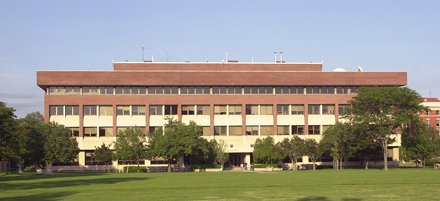Link Hall Special Collections Research Center
Page featured image content

Link Hall, SU Photo & Imaging RS 8794
Page main body content
Ground Broken: March 1968
Opened: April 1970
Dedicated: October 16, 1970
Dedication Speaker: Charles C. Johnson, Jr., administrator of Environmental Health Service, Department of Health, Education and Welfare
Named for: Edwin Albert Link, founder of Link Aviation and inventor of Link Flight Trainer and simulators used to train military and commercial pilots
Cost: $6 million
Funding: Donation from Edwin Albert Link and his wife Marian Clayton Link, alumnae and trustee of SU
Funding: National Science Foundation, $607,000; Department of Health, Education and Welfare (title I) $470,876 and (title II) $945,642
Materials: reinforced concrete with red brick and limestone trim
Contractor: JGA Construction Company
Architect: King & King, Syracuse
Location: Quad, next to Slocum Hall
Space: 102,594 square feet
Renovation: 2000
Architect for Renovation: Mike Wolniak, Class of 1978
Cost of Renovation: $4.5 million
Addition of Link+: 2008
Dedication: April 25, 2008
Cost: $10.1 million
Funding: New York State, $6 million
Space: 10,164 square feet
Architect: Toshiko Mori Architects, New York, NY
Notes: Originally named the Edwin A. Link Hall of Engineering. Built with six levels, two underground and four above. The basement and sub-basement were previously completed in 1954 during construction of William Lawyer Hinds Hall, then called Engineering building #1. At its dedication, Link Hall was the largest building on campus prior to the completion of Bird Library. The 2000 renovation created a new suite of state-of-the-art laboratories for environmental research on the fourth floor. The Link+ addition added five stories onto the north side of the building which housed research labs for both the engineering college and the Center of Excellence in Environmental and Engineering Systems. The addition included "green" elements such as natural daylight in the offices and carpeting of recycled materials. It also connected Link Hall to Slocum Hall.
